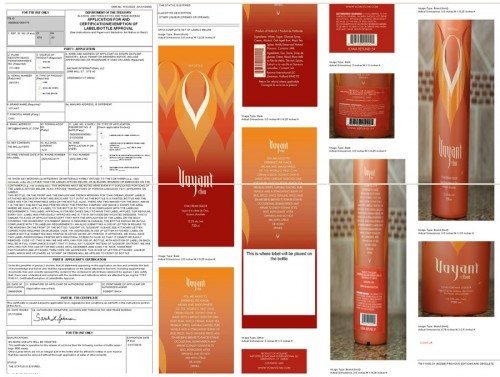Here is Bacmar’s use-up approval for Voyant Liqueur. It almost single-handedly proves it is not a good idea to print labels prior to TTB label approval. It looks painful and seems to have consumed a good part of Mr. Back’s spring and summer, from the April 2009 date of application until approval in July of the same year. The approval in all its fullness and glory, is here. In decades past, it was relatively easy to get “use-ups” (aka temporary approvals). But it seems to be getting harder and harder. In the 1990s it was a simple matter of asking, face to face. Now it can easily take more time, money and resources than the forlorn product is worth. The Voyant approval probably shows how hard it can be. On the other extreme, this Skyy approval tends to show how quickly it can go, and then Jumbie is somewhere in the middle. TTB’s main use-up policy is here. We like to think we’ve helped many companies avoid a Back-breaking struggle with TTB. In some situations, though, it can be difficult to avoid.
Continue Reading Leave a Commentpolicy
Ingredient Labeling on Wine
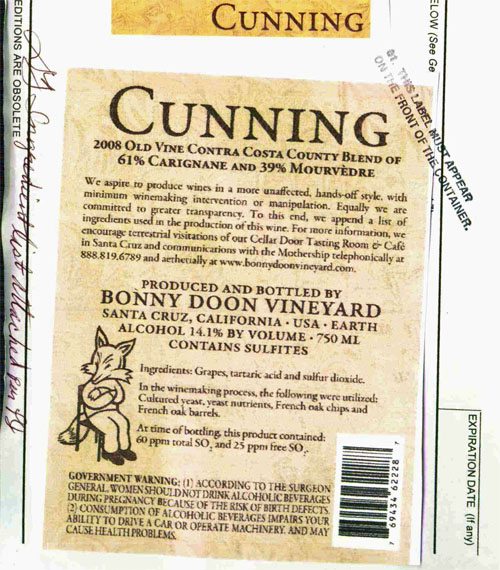
Back in the 1970s ATF/TTB worked vigorously to control wine-labeling, where FDA wanted to get involved and insist upon detailed ingredient lists, as is common on most other food labels. The matter got resolved by way of Brown-Forman Distillers Corp. v. Mathews, 435 F. Supp. 5 (W.D. Ky. 1976). But this did not stop Bonny Doon Winery. Many of Bonny Doon’s labels include quite detailed ingredient labeling, and Bonny Doon has been one of few alcohol beverage companies willing to swim against the tide and volunteer this information. Bonny Doon’s Cunning label shows the following ingredients: grapes, tartaric acid and sulfur dioxide. It goes on to say the product was made with cultured yeast, yeast nutrients, French oak chips, and French oak barrels. According to Decanter, Bonny Doon president Randall Grahm said:
It’s useful to provide more detailed information about the ingredients used in wine production and reduce our dependence on standard wine additions, even those considered to be benign such as tartaric acid, bentonite, yeast nutrients, enzymes, sulphur dioxide.
Let us know if you see other TTB labels with detailed ingredient labeling.
Continue Reading Leave a CommentSoviet-Style Flag Over NH Capitol
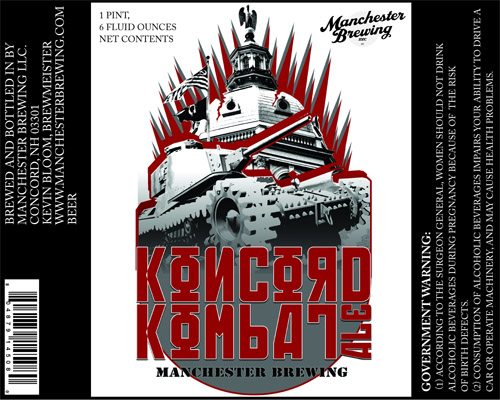
You can probably find some examples of American flags on TTB labels. But TTB usually does not allow it, and for that reason you won’t find one on this label. Manchester Brewing explains:
The feds forced us to remove part of the American flag, and replace the stars with a hammer and sickle. It’s the law, doesn’t have to make any sense. Originally, the Kombat ale was a Special Bitter, but it’s moved a bit beyond that.
A better view of the modified flag is here. Is it any wonder that TTB rejected a bunch of Manchester’s labels? Manchester goes on to explain:
Continue Reading Leave a CommentSmacked Down by The Man! The TTB rejected all of our labels! One had a flag over the capitol; it was an American flag but that’s not allowed — so we put a Hammer and Sickle where the stars go, and that’s ok. Also, we used OMFG! on another label, and the government decided that was obscene, even though we protested that it meant Oh My Fairy Godmother and told them we were sticking to that story. So now it says “Censored” over the OMFG, and people tell me they find that funnier.
California Rum
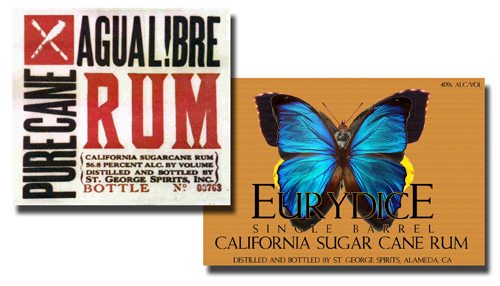
Most of the world’s rum is produced in the Caribbean. Not a lot has been made in the US. But lately there are signs of incipient production in California. Here are two: Agua Libre and Eurydice. Both are made by St. George Spirits in Alameda, California. A Swedish blog explains:
Eurydice starts with the fresh-pressed cane juice of 100% California-grown sugar cane. The cane, grown in Southern California, is harvested and crushed at St George Spirits’ Alameda facility where it is fermented with two strains of wine yeast designed to accent the fruit and floral notes of the cane.
It is good to see that TTB is not asserting that an appellation may not be indicated. On some occasions TTB has asserted that vintage-, varietal-, and appellation-type claims should not be made on distilled spirits products because these subtle characteristics are not discernible after distillation.
Continue Reading Leave a CommentTaurine
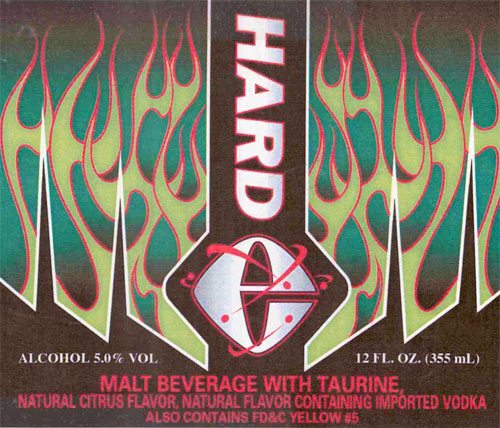
Taurine has been widely used in alcohol beverages for about ten years. One of the early approvals is Hard E Malt Beverage with Taurine, as above. Another early example is Sparks with Caffeine, Taurine, Guarana and Ginseng, from a few months later. Taurine showed up in TTB/ATF products around 2001, a few years after Red Bull hit the US. Red Bull famously contains taurine as well as caffeine and B vitamins. Some, like CSPI, have said taurine is of dubious legitimacy in food, but this article points out that Red Bull sells the beverage, with taurine, in well over 130 countries. The US of course is among those countries and there is no big sign of FDA concern. France had banned Red Bull with taurine for many years but began allowing it in April of 2008. On this occasion, the company said:
Last year alone, over three and a half billion cans and bottles of Red Bull energy drink were consumed in over 143 countries across the world and no one anywhere has ever shown any link between [the product] and harmful effects. Red Bull could only have such global sales because health authorities across the world have concluded that [it] is safe to consume.
The term is derived from “taurus,” Latin...
Continue Reading Leave a CommentTags: ingredients, policy
Bacardi with Aloe

Here is Bacardi Torched Cherry Rum with Natural Flavors. It is apparently made with “torched plant aloe.”
The use of aloe as a flavor is curious because it’s not clear how aloe tastes, and various sources say aloe does not taste especially good. This product is one of very few TTB products that seem to contain aloe. Even these find no room for aloe. As of this writing, the other flavors in the line are:
- Dragon Berry
- Limon
- Peach
- Raspberry
- Orange
- Coconut
- Apple
- Melon
Apart from aloe, this label suggests TTB will allow the term “Rum” to appear larger than “with natural flavors.” And yet, on other distilled spirits specialties, such as an identical product made with a vodka base, it is unlikely TTB would allow “Vodka” to appear in a more prominent way compared to the rest of the statement of composition. It is not clear why TTB polices the term “vodka” so rigorously, but not other comparable terms, such as “rum.” Another example of this is, the government clearly allows “cherry rum” (as above) but would probably not allow “cherry vodka.” This example is easier to understand because, as a matter of law and history, rum is only made from cane products, so confusion is unlikely....
Continue Reading Leave a CommentTags: brand extensions, ingredients, policy, statement of composition
